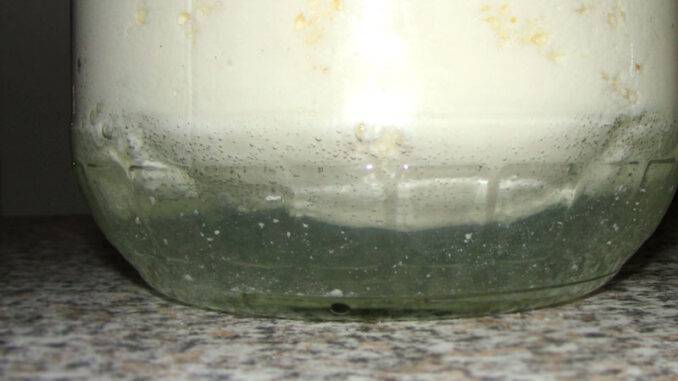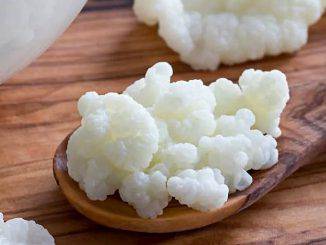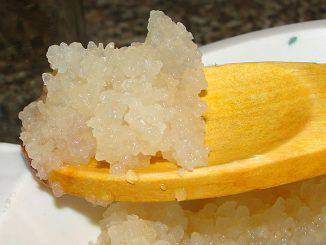
The separation of Kefir during fermentation is one of the most common occurrences, especially during the warmer months of the year. When their Kefir separates, fellow Kefir “newbies” even ask us whether their Kefir is “still good” or got somehow “spoiled.”
There is no reason to worry! There’s nothing wrong with your Kefir if the whey got separated from the thicker layer.
Separation of Kefir is a normal sign of over-fermentation, and it is fully reversible. You just need to either shake the jar or stir the liquid with a non-metal spoon. Your Kefir will be back to normal. As simple as that!
However, let’s shed a bit more light on this problem:
Is the separation of Kefir the same as milk curdling?
No! The processes involved in the separation of Kefir are not the same as those in milk curdling.
Milk is a colloidal solution (suspension), which means that the small protein molecules are “suspended” freely in the liquid.
When an acid (like lemon juice or vinegar) is added to hot milk, the acidity level of the milk increases and the protein molecules begin to coagulate, forming larger molecular chains known as curdles. Similar processes are used in Cheesemaking, but the acid used here is called rennet.
A typical characteristic of milk curdling is that it is irreversible. Once curdled, milk can no longer be reverted to its “original” colloidal state. The reason is that milk curdling involves biochemical reactions that change the molecular structure of milk proteins.
And here comes the essential part: Kefir fermentation is already a process of coagulation, thanks to the bacteria converting lactose into lactic acid.
Simply put, fermented Kefir is already coagulated milk. Its separation is not a result of any further coagulation and does not involve any further biochemical reaction.
So, unlike milk curdling which involves biochemical processes, separation of Kefir is just a physical separation of the already coagulated milk into a liquid part (whey) and a thicker layer of curds.
That is why this physical separation is fully reversible, and Kefir can be easily reverted to its original homogenous state by simply stirring it.
What are the reasons behind Kefir’s separation?
As we already said, separation of Kefir is a sign of over-fermentation. There could be only three reasons behind this over-fermentation:
- Incorrect Kefir grains to milk ratio. (Too many grains for too little milk)
- Too high temperatures of fermentation.
- A too long period of fermentation.
Any fermentation process depends on three factors: the quantity of the ferments (in our case – the Kefir grains), the ambient temperature, and the duration of fermentation. Excess in any of these three factors will result in over-fermentation or, in our case, separation of Kefir.
How to avoid the separation of Kefir?
If you have not recently changed your routine of brewing Kefir, the most probable reason for over-fermentation may be that with time your Kefir grains have grown too much and now exceed the quantity needed for your usual volume of milk.
Actually, this is one of the most common mistakes made by Kefir beginners. Fortunately, this is also one of the problems with Kefir which has the simplest solution.
You only have to decrease the number of Kefir grains you add to your usual volume of milk and give the excess of grains to a friend who may need them. Your remaining grains will continue to grow anyway and very soon you will have them in excess again.
Alternatively, especially in the warm days of summer, it is a good idea to carry out the entire fermentation in the refrigerator. In this case, fermentation may take longer than usual, but you will not run into the risk of over fermenting your Kefir.
Moreover, longer fermentation at lower temperatures usually results in smoother, thicker, and more homogenous Kefir. Remember that slower fermentation usually gives better results.
Finally, to avoid Kefir separation, closely monitor the fermentation and strain out the Kefir grains as soon as your Kefir appears to be ready and tastes as expected. In the warmer summer days, don’t wait for the 12 hours kefir usually needs to ferment.
A good sign that your Kefir is ready is the appearance of small pockets of whey within the brew. Actually, the separation of Kefir is nothing but a consolidation of these pockets of whey when they get too big and too many.
What to do if Kefir is separated?
As we said earlier in this article, the separation of Kefir is a normal part of fermentation and is not a reason to worry. Usually, just stirring the Kefir mix with a wooden or plastic spoon would be enough to revert it to its initial homogenous state.
Over-fermented Kefir, however, may have a rather intense, tangy, and even acid taste some people may not appreciate. No worries, though, because there are many ways over fermented Kefir may be used.
First of all, it may be used as an excellent base for making Kefir cheese. In this case, separation of Kefir has even an advantage because it facilitates the drainage of whey from the curds.
Over-fermented Kefir is also valuable to many cooking recipes, including Kefir smoothies, Kefir ice-creams, Kefir cookies, Kefir pancakes, Kefir bread, and many others.
Additionally, over-fermented Kefir may be used for cosmetic purposes as an essential part of face masks, body lotions, or direct skin application.
Is it possible to “fix” over-fermented Kefir?
Good question, indeed! When Kefir over-ferments, its taste becomes tangy and acidic, and some people may dislike it.
Yet, there is a straightforward solution to this issue.
Once you have stirred the over-fermented mixture until it gets smooth and homogenous again, bring the mixture through a strainer and separate the grains, as you usually do.
Here comes the key step: instead of directly consuming the over-fermented Kefir, add some fresh milk and leave it in the refrigerator for another 12 to 24 hours.
In this way, instead of using Kefir grains for making Kefir (as we usually do), we will use our over-fermented product as “mother culture” to create a new fresh batch of kefir.
The only thing left is to periodically check your new batch of Kefir until you like its taste.
It is worth mentioning, though, that making a new batch using only over-fermented Kefir (with no grains inside) is a “one-off” possibility. Unlike yogurt that can be repeatedly inoculated by just adding a portion of older yogurt to fresh milk, the preparation of Kefir, in the long run, requires the presence of Kefir grains.
Summary
Separation of Kefir is a perfectly normal process that is a sign of over-fermentation. While over-fermentation is not a reversible process, separation is fully reversible. You just need to stir the mixture to revert it back to its initial homogenous state.
Kefir over-fermentation (resulting in its separation) can be caused by any of these three factors:
- Too many grains for the specific quantity of milk.
- Too high temperatures of fermentation.
- A too long period of fermentation.
By manipulating any of these factors it is easy to prevent the separation of Kefir.
Related questions
- What can I do with over-fermented Kefir if it’s too strong and I don’t like its taste? Over-fermented Kefir can be used in a variety of ways, including for making Kefir cheese, Kefir smoothies, Kefir ice-creams, Kefir cookies, Kefir pancakes, Kefir bread, and many others. Over-fermented Kefir may be also used for cosmetic purposes as an ingredient for face masks, body lotions, or direct skin application.



